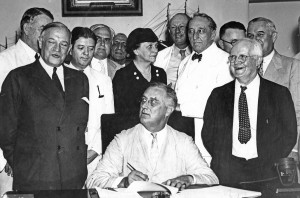
Frances Perkins, 1935
Perkins served as Secretary of Labor from 1933-1945
Photo Credit: Courtesy, Frances Perkins Center
Some 95 million Americans collect Social Security and unemployment insurance benefits, yet few today know about Frances Perkins, the woman responsible for the social safety net so many depend on.
Perkins (1880-1965) was the first woman ever appointed to a presidential cabinet. She served as FDR’s Secretary of Labor from his first term in 1933 until his death in 1945. “I came to Washington to work for God, FDR and the millions of forgotten, plain, common workingmen,” she said.
A savvy and trusted advisor to Roosevelt, Perkins accepted the job as U.S. Labor Secretary on the condition that he let her pursue what she called “practical possibilities.” Those possibilities encompassed a broad portfolio of policy initiatives, including landmark legislation that enacted unemployment insurance and Social Security, widely viewed as the most effective anti-poverty program in U.S. history.

Inspecting the construction of the Golden Gate Bridge
San Francisco, 1935
Photo Credit: Courtesy, Frances Perkins Center
Author Adam Cohen extolled Perkins in the introduction he wrote to her biography of FDR, “The Roosevelt I Knew”: “If American history textbooks accurately reflected the past, Frances Perkins would be recognized as one of the nation’s greatest heroes—as iconic as Benjamin Franklin or Thomas Paine. Like Franklin, Perkins was a brilliant self-creation: There had not been anyone like her before and there has not been anyone like her since.”
To shine a light on Perkins’ underknown legacy, the Frances Perkins Center, established in 2009, has acquired the place Perkins considered her true home—a 57-acre farm that was settled by her ancestors on the Damariscotta River in Newcastle, Maine. Perkins spent her childhood summers at the 1837 “Brick House” surrounded by fields, forests and miles of stone walls and returned throughout her life. She is buried in the local cemetery.
Designated the Frances Perkins Homestead National Historic Landmark in 2014, the property will serve as the Center’s headquarters and as a living memorial to its namesake when it opens in 2021. Exhibits, public programs and community use will follow.
A $500,000 matching grant to the Center from the National Park Service’s Save America’s Treasures program, awarded in August, is a major step toward realizing the Center’s long-held vision and $5.5 million capital campaign goal.

Perkins greets FDR
FDR’s return from the Teheran Conference, December 17, 1943
Photo Credit: Courtesy, Frances Perkins Collection, Rare Book & Manuscript Library, Columbia University
Perkins relied on facts and well-crafted legislation rather than “fiery rhetoric” to address social ills, on the advice of her mentor, Florence Kelley, the legendary progressive for whom Perkins worked. Perkins’ outrage at witnessing the Triangle Shirtwaist Factory fire in New York City in 1911, which killed 146 young workers for lack of safety codes, led her to Albany as a factory investigator and a series of key government positions culminating in her appointment as state Labor Commissioner by Governor Franklin Roosevelt. She lobbied for worker safety laws that became models for the nation. She later said, “the New Deal began on March 25, 1911,” the day of the fire.
Though her handiwork often went unrecognized, Perkins’ proposals laid the foundation for New Deal social policies. Her persistence and political skills as Labor Secretary brought them to fruition. Consciously dressing to appear “motherly” and unthreatening in a political world dominated by men, Perkins chaired key panels, hired brilliant aides, cajoled naysayers, built coalitions, and helped launch large-scale public works programs to create millions of jobs for skilled and unskilled workers.
Her legacy includes the first federal minimum wage laws, restrictions on child labor, provisions for workers’ safety and the right to unionize. Her biographer, Kirstin Downey, aptly credits Perkins as “the woman behind the New Deal.”





